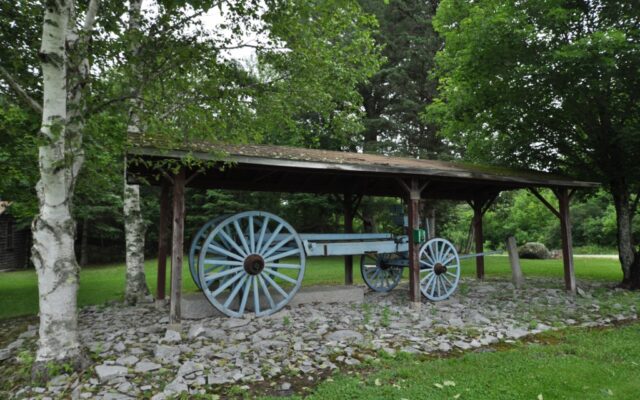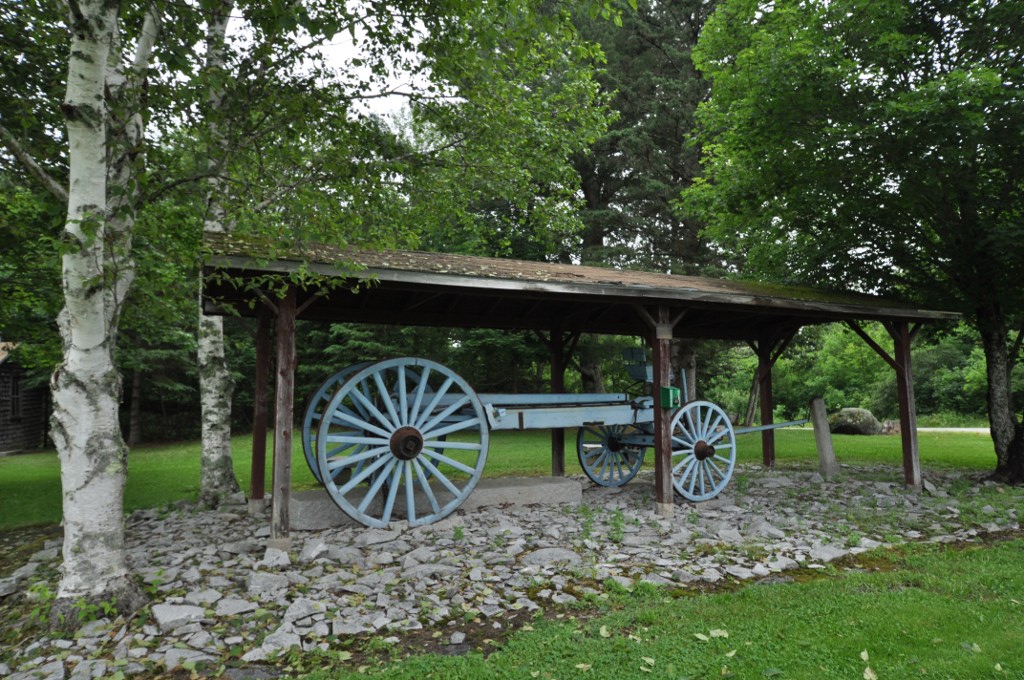
These hulking machines in Maine are the last of their kind in the world
By Emily Burnham, Bangor Daily News Staff
The word “galamander” brings to mind some sort of mythical beast. A dragon, perhaps, or a giant salamander. Maybe some bizarre monster stalking the forests of Maine that workers in the woods claimed they saw in centuries past, like the Tote Road Shagamaw, or the Agropelter.
In reality, a galamander has a far more practical origin story — though the only two remaining examples of them left in the world are in Maine, and are just as hulking and imposing as its name might suggest.
A galamander is a specialized stone-hauling vehicle used by workers in Maine’s granite quarries in the 19th and early 20th centuries, though it’s believed similar machines were used by ancient Romans. They are typically about 18 feet long, and have four gigantic wheels and a wide platform. An attached derrick would lift granite slabs onto the vehicle, which was hauled by teams of oxen or horses.

GALAMANDER — Robertson Quarry Galamander, Franklin, Maine. A galamander is a specialized wagon for hauling stone.
Nobody seems to know where the name “galamander” came from, but nevertheless that’s what Mainers knew them as. They were enormous, heavy, strange-looking and unwieldy — and a remarkably effective invention for the specific task of hauling tens of thousands of pounds of granite cut from Maine quarries.
In the 19th century, galamanders were used in quarries all across the state, like the famed quarries in Stonington or the Mount Waldo Quarry in Frankfort. As the industry declined in the early 20th century when concrete and reinforced steel replaced granite in most building construction, however, the machines fell into disuse and eventually were dismantled.
Though the description sounds simple enough, it’s actually an incredibly rare machine with only two known left in the world. One of them, the Vinalhaven Galamander, is located in a park in the island community. While its metal parts are original, its wooden parts were reconstructed in the 1960s, after the original ones deteriorated.
Between the 1820s and the 1940s, Vinalhaven’s Bodwell Granite Company operated some of the most prolific quarries in the state, and at one point had multiple galamanders in operation, all painted in a distinctive shade of blue. The Vinalhaven Historical Society said the largest one, nicknamed “Jumbo,” was so big it had to be drawn by a team of eight horses.
The other galamander, located in a small park on Route 182 in the Hancock County town of Franklin, is fully intact, and is the only complete galamander known to exist. It was used at Robertson Quarry in Franklin, one of more than 30 granite quarries in Hancock County during the peak of the industry. The Franklin galamander was placed on the National Register of Historic Places in 1992.
Those two odd-looking machines are some of only large pieces of machinery left that were used during the heyday of Maine’s granite industry. Just as many of the homes built in the U.S. in the mid-19th century as Americans pushed westward were constructed from Maine lumber, so were many of that era’s public and commercial buildings constructed from Maine granite.
There were active quarries all over the southern portion of the state, as far south as Berwick and as far north as Guilford, and stretching all the way Down East to Calais. The industry employed thousands of people, including many 19th century immigrants to Maine, with Italian, Swedish, Finnish and Scottish people moving to Maine to work in the quarries.
Maine granite was prized by architects all over the country and was used in monumental structures such as the Brooklyn Bridge, the United Nations, the Washington Monument, the Pentagon and several Smithsonian museums. Fort Knox in Prospect is constructed entirely of Maine granite, as are many of the bridges and other stone elements in Acadia National Park.
Today, there are only a handful of active granite quarries around the state, with Maine granite considered a high-end product used for things like countertops and landscaping projects. Many old quarries are now used for hiking, biking and as nature preserves, while others are closed to the public — though some people still try to swim in quarries, despite them often being highly unsafe.
Galamanders haven’t been used for more than a century, with the decline in the granite industry occurring around the same time as gas-powered engines became the norm. As symbols of a once-booming industry in Maine, however, the two remaining galamanders are odd remnants of a time when Maine resource extraction — be it granite, lumber, ice, lime or seafood — powered not just the state’s economy, but much of the early economic growth of the country as a whole.